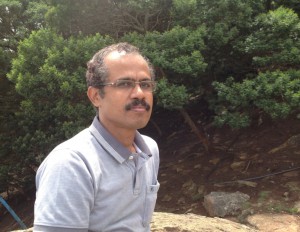The division of Avian Physiology and Genetics conducts basic and applied research, especially in the fields of avian reproductive and endocrine sciences, and biomaterials management, to understand biological mysteries and implement practical solutions to help species survive. Avian Physiology and Genetics scientists have pioneered innovative approaches to help improve reproductive outcome of birds and other wild animals around the world. Currently, we are establishing an avian bio-bank and an avian forensic facility at the centre.
 Dr. Pramod, Senior Principal Scientist
Dr. Pramod, Senior Principal Scientist
email: pramodp.68@gov.in
 Dr. Ashutosh Singh, Scientist
Dr. Ashutosh Singh, Scientist
email: ashutoshs.86@gov.in
Mr. Prateek Dey, Ph.D. Student
I am a postgraduate in Life Sciences (5 years Integrated M.Sc) from the Central University of Tamil Nadu. After my postgraduation, I worked as a Research Assistant at the Centre for Ecological Sciences, Indian Institute of Science, Bangalore. At CES, IISC, I was working on the genetics and parasites of birds.
Currently, I am pursuing my Ph.D. in the field of avian genomics from SACON, and registered at Bharathiar University. I joined SACON as a Junior Research Biologist in a MoEFCC funded project on “Establishment of National Avian Forensic Laboratory at SACON, for National Certification to prevent Illegal trafficking of birds” under the supervision of and co-supervision of Dr. P. Pramod. For my Ph.D. dissertation, I am assessing genomic variations amongst wild and domestic species of birds using Next Generation Sequencing tools under the guidance of Dr. Ram Pratap Singh. As a result of our teams’ work, we have sequenced the first and second high-quality avian mitogenome for the very first time from India. Currently, our team is involved in whole genome sequencing of several species of Indian birds. I have more than 3.5 years of hands-on experience in the whole genome assembly (using various De-novo/reference-based tools), cleaning and quality controlling the assembled genomes, annotating genomes, identifying and validating novel microsatellite motifs, and also performing tertiary evolutionary/genomic analyses on the sequenced genomes in a LINUX based environment.
Ms.Anamika Gautam, Ph.D. Scholar, UGC NET (JRF & LS)
I took up Zoology as a subject in my graduation. During the course, I was highly allured by the gorgeous world of birds. To understand the different aspects of the rapidly changing world and concerns associated with conservation; I chose Environment science as my subject in my master’s. During my master’s, I got an amazing opportunity to work on a project titled “Regime shifts in ecosystems” at CES IISc Banglore. Also, I have experience of handling large data sets, as during my dissertation taken from the Central Pollution Control Board (CPCB) website. I Joined SACON as a Junior Research Biologist (Genetics) at the avian physiology and genetics division in a MoEFCC funded project on “Genetic diversity and phylogeographic patterns of Passer domesticus from the select landscape in India”. Working one year in this project help me understand more about House Sparrow through molecular tools.
Currently, I am affiliated to SACON as a Ph.D. Scholar. For my Ph.D., I am exploring how urbanization can impact on house sparrow and host-pathogen relationships. My research interest includes urban ecology, molecular taxonomy, zoonotic disease and wildlife forensics. I am keenly interested to contribute and pursue my career in the conservation of wildlife.
Ms. Bhawani Sabat, Junior Research Fellow, (CSIR NET- LS)
I am from the Koraput area also known as the “Heaven of Odisha” located in the eastern ghats, which is famed for its lush valleys, forests, fauna, darting springs, and waterfalls. Coming from a tribal group has always piqued my interest in wildlife and its splendor. Since childhood, I have enjoyed traveling, trekking, Photography, and observing animal behavior in their natural habitat. While observing wild species and their unique behavior sparked my interest in pursuing a career in wildlife discipline to gain in-depth knowledge and contribute towards their conservation. I did Bachelor’s in Zoology and completed a Master’s in Zoology from Berhampur University, Odisha. During my master’s I actively participated in several events (including workshops and seminars) that were focused mainly on conservation aspects of different wildlife species, which brought a deep interest of myself in studying birds and butterflies. Therefore, after finishing my master’s I chose to pursue a career in wildlife research. Currently, I am working as a Junior Research Fellow (JRF) under DST-SERB funded project titled “Taxonomic characterization of select Galliformes of India using feather morphometrics and DNA for application in wildlife forensics.” Through this project, I am trying to develop the database and protocols for morphology and taxonomic identification of select Galliformes species that can be used for forensic investigation. Before joining SACON, I also served as Lecturer (Zoology) at Times College of Science and Commerce, Jeypore, Odisha, and recently completed an online internship based on the “Life Science Research Associate Role.” I am eager to contribute my work and advance my career in wildlife science.
Research Projects – Ongoing
Research Projects – Completed
The NAFL was established by SACON in 2018 with financial support from MoEFCC. The NAFL has facilities for analysis of bird body parts and a repository of tissue/blood and feather reference materials to help identify avian species from their remains. The NAFL was developed to support law and enforcement agencies in controlling illegal bird trafficking and to help military and civil airports identify birds involved in bird–aircraft collisions. The NAFL is equipped with sophisticated as well as common laboratory equipment including a next generation DNA sequencer, a Sanger DNA Sequencer, a Covaris, a fragment analyser, horizontal and vertical gel electrophoresis systems, a centrifuge, a gel-documentation system, deep freezers (-80°C), a biosafety cabinet and thermal cyclers polymerase chain reaction machine. The NAFL also conducts training programmes in conservation genetics, DNA sequencing and identification of bird remains through DNA and feather structures of bird species for various user agencies.
The NAFL was dedicated to the nation on 28 September 2018 by Shri C. K. Mishra, IAS, Secretary, MoEFCC.
Brochure